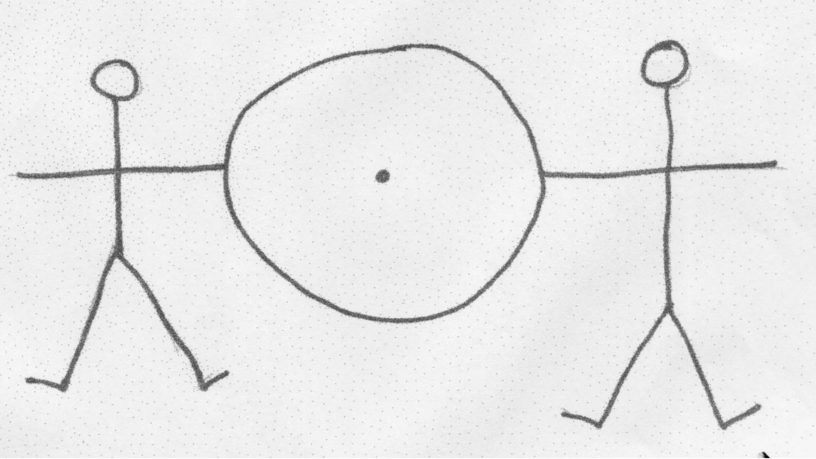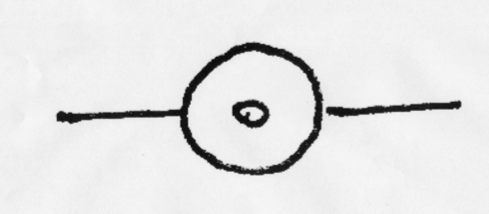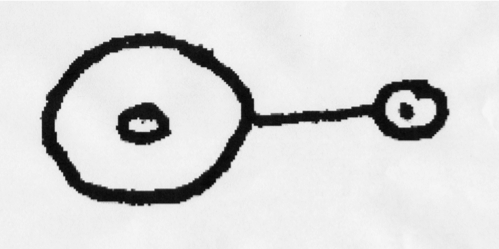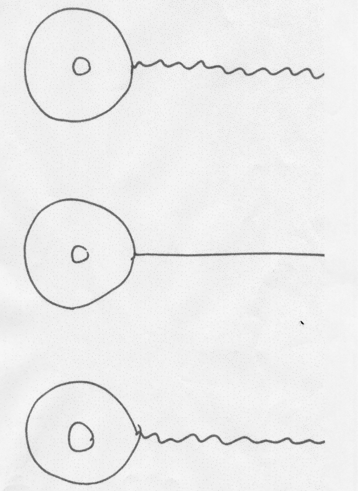"Droodle Me This ... ": Pictorial Declarations and the American Dream Maria Teresa Agozzino
A "true" droodle is purposely ambiguous and misleading and may depend on word play and known stereotypes (Preston, "Graphic Riddle" 108). Like a true riddle, a true droodle provides enough infor- mation for the viewer to deduce the answer, but the references are rarely literal and there may be more than one possible solution.  For example, traditional solutions for the droodle in Figure 1 are both, "A Giraffe Passing a Window" and "A Bear Climbing a Tree" (Brunvand, Study125). [6] This text assumes prior knowledge of giraffes, bears, trees, square windows, and multi-story buildings; not uniquely American motifs but not universal either.
For example, traditional solutions for the droodle in Figure 1 are both, "A Giraffe Passing a Window" and "A Bear Climbing a Tree" (Brunvand, Study125). [6] This text assumes prior knowledge of giraffes, bears, trees, square windows, and multi-story buildings; not uniquely American motifs but not universal either.
Figure 2: "Two Men Walking Abreast."[7]
The droodler may manipulate the pictorial perspective by pre- senting an unusual angle or a fragment, or by purposefully disguising the intended image within a more obvious form, perhaps comedic or risqué. [8] Moreover, the solution to the droodle in Figure 2 is language-dependent, relying on direct word play (Preston, "Graphic Riddle" 109).
Deliberate depictions of simple but ubiquitous and exaggerated stereotypes readily signal specific ethnic or cultural groups such as a large round circle, often with an inner concentric ring, to represent an aerial view of alternatively a Mexican sombrero, a cowboy hat, or a straw hat worn by Chinese peasants. This droodle thrives in the United States because stereotypes of Mexicans, Chinese, and cowboys are embedded in America's cultural memory and require no further explanation. [9]  The hat motif appears in a number of droodles, often drawn Figure 3: "Mexican [or Cowboy or Chinaman] Riding a Bicycle." [10] in sequence, giving the newly-initiated a signal to help him or her solve the new context.
The hat motif appears in a number of droodles, often drawn Figure 3: "Mexican [or Cowboy or Chinaman] Riding a Bicycle." [10] in sequence, giving the newly-initiated a signal to help him or her solve the new context.
Figure 3: "Mexican [or Cowboy or Chinaman] Riding a Bicycle."
To solve the droodle shown in Figure 5, the responder must demonstrate a competency with ethnic stereotypes coupled with a dose of lateral thinking.  This aerial rendition of three men communing while fulfilling a natural bodily function cloaks the reality of immigrants' cramped living conditions in a scene of camaraderie and intimacy. [12]
This aerial rendition of three men communing while fulfilling a natural bodily function cloaks the reality of immigrants' cramped living conditions in a scene of camaraderie and intimacy. [12]
Figure 4: "Mexican [or cowboy, or Chinaman] frying an egg or making breakfast." [11]
Droodles, therefore, are typically culturally relative and culturally reflective; they are at once culturally produced and culture-dependent. Decoding requires specific knowledge of the cultural code in which and with which the droodled information is transmitted (Roemer, "Beholder" 176, 178; Kaivola-Bregenhøj 63). For example, a sketch of a circle denoting a Mexican sombrero would not resonate in Finland, nor would it serve any folkloric function -- not having a shared history or direct cultural contact, it is unlikely that Finns would derive any benefit from embracing traditional American stereotypes about Mexicans.  However, the transmission of ethnically-driven droodles outside the originating context may facilitate diffusion of previously localized stereotypes and so propagates pre-judgments where they may not have previously existed (Kaivola-Bregenhøj 63). [14] In "A Study of Ethnic Slurs: The Jew and the Polack in the United States," Dundes writes, "It seems clear that stereotypes do contribute materially to the formation and perpetuation of deep-seated prejudices" (186). Although shrouded in humor, whether accurate, insensitive, or exaggerated, stereotypes exist in folklore for a reason. For example, the tenacity of ethnic stereotypes reflects a persistent fear, ignorance, and marginalization of immigrants, who, after all, are lured to the United States by the promise of the American dream.
However, the transmission of ethnically-driven droodles outside the originating context may facilitate diffusion of previously localized stereotypes and so propagates pre-judgments where they may not have previously existed (Kaivola-Bregenhøj 63). [14] In "A Study of Ethnic Slurs: The Jew and the Polack in the United States," Dundes writes, "It seems clear that stereotypes do contribute materially to the formation and perpetuation of deep-seated prejudices" (186). Although shrouded in humor, whether accurate, insensitive, or exaggerated, stereotypes exist in folklore for a reason. For example, the tenacity of ethnic stereotypes reflects a persistent fear, ignorance, and marginalization of immigrants, who, after all, are lured to the United States by the promise of the American dream.
Figure 5: "Three Mexicans Peeing Into Urinals and the Middle One is Telling a Joke." [13]
Maria Teresa Agozzino has a Ph.D. in Folklore and Celtic Studies from the University of California, Berkeley, where she served as Head Reader for Alan Dundes from 1999-2004 and as Head Archivist from 2000 to 2004. She has taught folklore and American Studies courses at UC Berkeley and California State University, East Bay. Her publications include "Welsh Calennig and Greek Kalanda: Begging in the New Year," Cosmo: The Journal for the Traditional Cosmology Society 19 (2005): 21-45, "Ysbryd y Werin: An Overview of Celtic Folklore Scholarship," The Folklore Historian 22 (2005): 13-33, and "First Come, First Served: Investigating Sir John Rhys' 'Essential Connexion' between Celtic New Year Customs." Studi Celtici: An International Journal of History, Linguistics, and Cultural Anthropology 2 (2003). This paper evolved from a guest lecture presented to an introductory American Studies course at UC Berkeley in fall 2005. She is much obliged to Christine Palmer for the opportunity.
